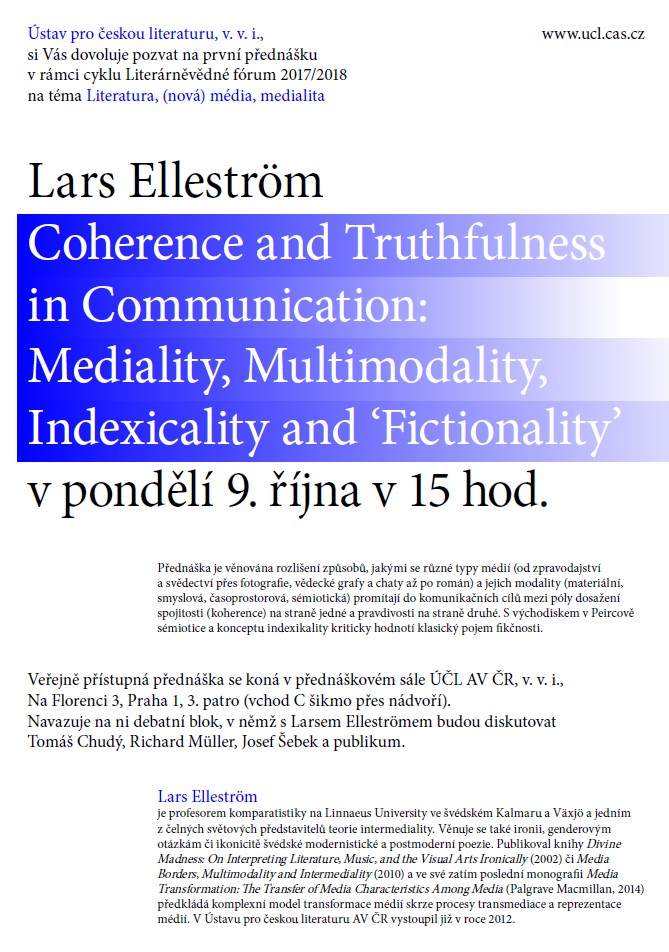9. října od 15:00 prosloví v přednáškovém sále ÚČL AV ČR Lars Elleström (Linnaeus University) přednášku „Coherence and Truthfulness in Communication: Mediality, Multimodality, Indexicality and ‚Fictionality‘“.
Touto přednáškou zahajujeme cyklus Literárněvědné fórum: Literatura, (nová) média, medialita (program pro zimní semestr zde).
Lars Elleström, jeden z čelných světových představitelů teorie intermediality, vychází ve svém výzkumu z jednoduchého předpokladu, že každé médium je zřejmé a vysvětlitelné právě a jedině ve vztahu k ostatním typům médií. Elleströmův model intermediálních vztahů patří k nejúspěšnějším aktuálním pokusům integrovat zájmy literární vědy a uměnovědy s hledisky teorie médií, mediálních studií a výzkumu nových médií.
Přednáška s názvem „Coherence and Truthfulness in Communication: Mediality, Multimodality, Indexicality and ‚Fictionality‘“ je věnována rozlišení způsobů, jakými se různé typy médií (od zpravodajství a svědectví přes fotografie, vědecké grafy a chaty až po román) a jejich modality (materiální, smyslová, časoprostorová, sémiotická) promítají do komunikačních cílů mezi póly dosažení spojitosti (koherence) na straně jedné a pravdivosti na straně druhé. S východiskem v Peircově sémiotice a konceptu indexikality švédský badatel kriticky hodnotí klasický pojem fikčnosti.
Na přednášku navazuje debatní blok, v němž se dostane na vzájemné výzvy literární a mediální vědy, Elleströmovo vlivné rozlišení médií na kvalifikovaná, základní a technická i na současná východiska teorie a dějin médií i literatury. S Larsem Elleströmem diskutují Tomáš Chudý, Richard Müller a Josef Šebek.
Lars Elleström, prof. komparatistiky na Linnaeus University ve švédském Kalmaru a Växjö. Zde pořádá Fórum pro intermediální studia, je předsedou Nordic Society for Intermedial Studies a International Society for Intermedial Studies (ISIS). Jeho publikace zahrnují mj. monografie Divine Madness: On Interpreting Literature, Music, and the Visual Arts Ironically (2002) či Media Borders, Multimodality and Intermediality (2010). Ve své zatím poslední knize Media Transformation: The Transfer of Media Characteristics Among Media (Palgrave Macmillan, 2014) předkládá komplexní model transformace médií skrze procesy transmediace a reprezentace médií a mj. pracuje i s interpretacemi krátkých filmů Jana Švankmajera. Ve svých studiích se vedle intermediality věnuje také ironii, genderovým otázkám, problematikou „sociosomatického onemocnění“, jak je tematizováno v próze konce 19. století, či ikonicitě švédské modernistické a postmoderní poezie. V Ústavu pro českou literaturu AV ČR vystoupil v roce 2012.
Lars Elleström is Professor of Comparative Literature, Linnaeus University, Kalmar and Växjö, Sweden. He organizes the Forum for Intermedial Studies, Linnaeus University, and chairs the International Society for Intermedial Studies (ISIS). He has written and edited several books, including Divine Madness: On Interpreting Literature, Music, and the Visual Arts Ironically (2002) and Media Borders, Multimodality and Intermediality (2010) where he presents a complex model of media transformation through the processes of transmediation and media representation, using, among others, the exempla of Jan Švankmajer’s short films. He has also published numerous articles on gender, irony, visuality in Swedish modernist and postmodernist poetry or “sociosomatic illness” as represtented in the late 19th century narrative fiction.
„Coherence and Truthfulness in Communication: Mediality, Multimodality, Indexicality and ‚Fictionality‘“
The aim of this paper is to form a conceptual framework for analyzing and understanding how coherence and, primarily, truthfulness is achieved in communication. I will sketch the contours of a model to be used for analyzing coherence and truthfulness in actual, complex, and often multimodal communication achieved by various kinds of media. The model is intended to encompass all conceivable media types including those that are comprehended as very different in terms of truthful communication: news reports, photographs, testimonies, novels, songs, chats, caresses, scientific diagrams, etc. It thus reaches far beyond the limited realm of language, and very far indeed beyond analysis of truth values in single verbal propositions. The approach is theoretical. More specifically, the model is prompted by intermedial issues and semiotic methods for analyzing meaning-making. Its core concept is Charles Sanders Peirce’s notion of index, which has been used surprisingly little in this research context. An index is a sign that evokes an object in the mind of the perceiver due to some real connection between sign and object; it is a sign based on contiguity. I argue that indices may represent objects in what I call the intracommunicational and the extracommunicational domains, respectively. Intracommunicational indexicality creates internal coherence in communication and extracommunicational indexicality produces external truthfulness in communication. The complex issue of external truthfulness may thus be disentangled to some extent by way of investigating the many forms of contiguity and represented objects – material and mental – involved in communication through various media types. On the basis of this multifaceted notion of external truthfulness I finally criticize the standard notion of fictionality that is commonly used in studies of literature, film, and other artistic areas.






